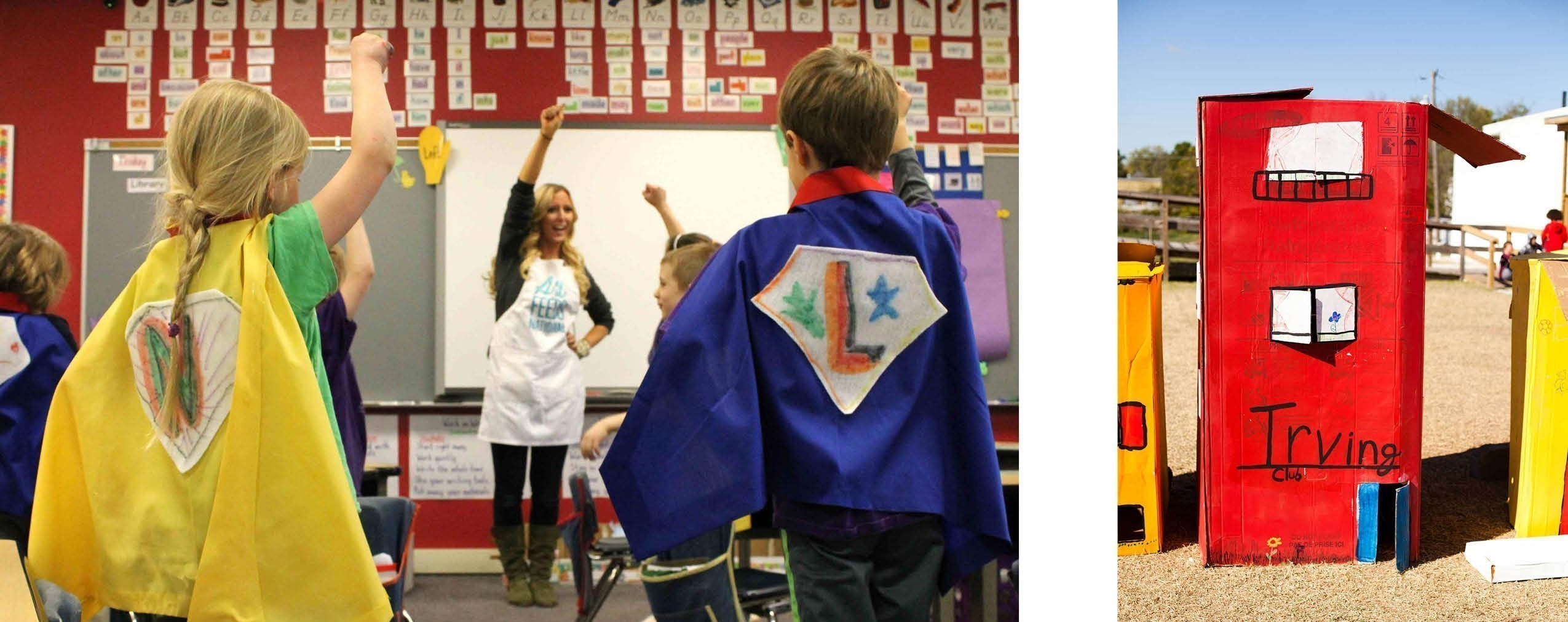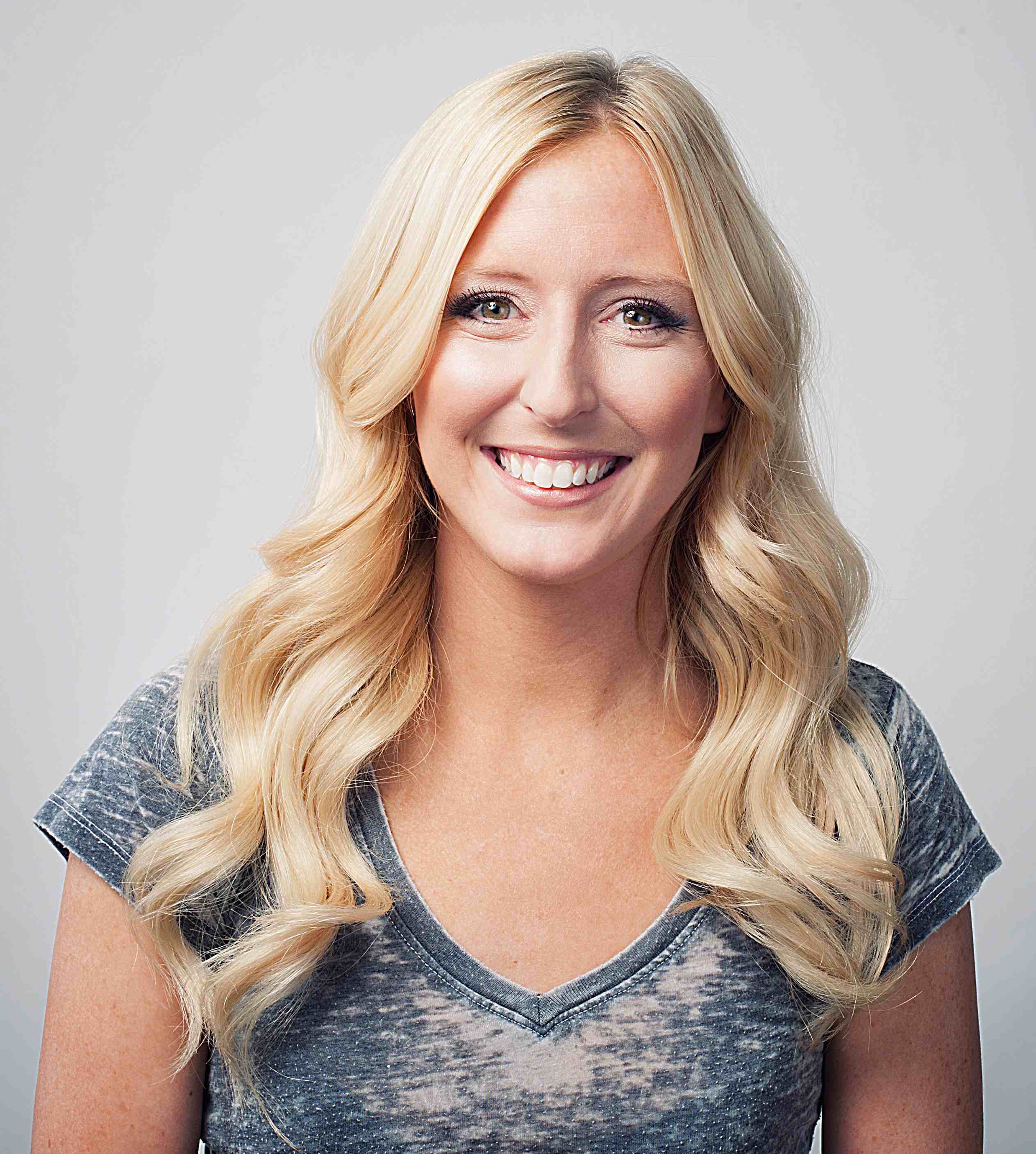
(L) Meg Bourne leading the students of Estes Park in a super hero oath at the end of a Heroes lesson from the Trauma Response Curriculum © Meg Bourne (R) In the Restore Joplin project, students designed new buildings for their community then got to create their designs out of refrigerator boxes. This image is of Irving Elementary, the student's school that had been destoyed © Meg Bourne
I can say with great certainty that the scariest moment of my life was May 22, 2011, as I climbed through my Joplin, Missouri, neighborhood shortly after the tornado. I say “climbed” because it’s the most accurate description—I literally had to climb over and through debris. There were cars in trees. Trees in houses. Ambulance sirens and the most horrible smell. It was as if every building had been shredded like paper, ripped to pieces. Structures that seemed strong had crumbled into nothing. Where my neighborhood once stood there were only piles of sticks, rubble, and trees. The only way I could identify my house was by the one standing wall that was the color of my living room.
I found my neighbor and dear friend, Amy, crying out desperately for her two children, Jack and Kayley, 4 and 7. These were the same children that left their small bikes in our yard and knocked lightly on the door early Saturday mornings asking if we could come play. Now they had vanished. I hugged Amy and while crying she said: “We will find them, but they aren’t here. They aren’t here.” They weren’t here, but where were they? We lifted up marred walls and crawled into a decimated basement, both hopeful and terrified of what we would find underneath.
As we searched for my neighbor’s children I resolved that if we found them alive I would do everything in my power to help them heal using the tool I was most familiar with—art
Elsewhere in the neighborhood a woman was searching for her daughter, who had spent the night at a slumber party across the street from me. This seemingly random event was echoed by a million other sickening moments just like it. Where were the children whom I knew and loved? And where were all the children in Joplin whom I didn’t know? Were they safe? Were they alive? As we searched for my neighbor’s children I resolved that if we found them alive I would do everything in my power to help them heal using the tool I was most familiar with—art.
In early 2009 I founded Art Feeds, which provided children with free therapeutic art and creative education that prompted students to draw, dance, paint, and sculpt. The curriculum was designed to facilitate expression and build creative capacity. Later this approach gave our organization the footing to be instrumental in students’ mental and emotional well-being following the disaster. Students needed a platform for healing after the trauma they had faced. Before the storm the organization was focused primarily on students with behavioral disorders, special needs, as well as on at-risk and marginalized students. We reached 200 to 500 children per week before the tornado, but all of our strategies changed in its aftermath.
Access for All
Sixteen days after the tornado hit we increased our program from 200 to 300 students per week to 2,000 students. This achievement grew by 40 percent each school year until, by 2013, every child in Joplin Elementary Schools—5,050 children in total--received access to the program.
The first night after the tornado I decided Art Feeds programming would no longer be only for marginalized children but for all the children in Joplin who needed help coping with the trauma they had faced. Indeed, the trauma affected all students—whether they had lost their homes, a loved one, or were simply disturbed by the city-wide wreckage. The shift from focus groups to the entire student body created the structure that our programming follows to this day.
Art Feeds programming is unique, as it reaches students in school, during the school day, and in interplay with curriculum. The in-school programming reaches students where they are and allows easy access to expression and creativity where they can begin the healing process. This eliminates barriers commonly seen in after-school or before-school programming. The programs are all-inclusive and free, so no child is ever barred from the program due to lack of money or transportation. We have formed strong relationships with the students and have made consistent progress in our benchmark goals to decrease fear, stress and anxiety, increase self-efficacy, increase resiliency and grow creative capacities. We do this by reaching students on a consistent and sustainable basis.

(L) Art Feeds provides every student with an art pack, a bag that has all the essential supplies for creating. These students are drawing in their sketchbooks, which are used by educators to track expression and creativity progress in Joplin MO © Meg Bourne (R) Meredith Allendorph, an ARt Feeds intern, works with Grant on a sensory project in Joplin MO © Meg Bourne
Art Feeds does not take class time from other subjects. Rather, it works in partnership with the school to enhance the learning experience with various forms of art and interactive learning. Typically, Art Feeds staff and volunteers set up in a common area in the school and each class filters into the common area for 30 minutes of instruction and activity. This occurs one day per week so that strong and ongoing relationships are formed between students and educators and ultimately create an environment in which students feel free and safe to express themselves.
At first, we found funding through Art Feeds social media presence, where our first major organizational grants were online voting competitions through avenues such as Vh1’s Do Something Awards, Chase Community Giving, and State Farm Neighborhood Assist. Young people are very active on social media, so we leveraged our online platform to make a difference. Once Joplin realized the impact our programming was making in the community post-disaster, funding came through the Joplin Recovery Fund, Community Foundation of the Ozarks, peer-to-peer fundraising platforms and even in the form of in-kind donations from shows such as Extreme Makeover: Home Edition, which gifted us with a Mobile Art Center. Each of these grants and donation sources also gave us a unique platform to tell our story on a nationwide scale and would allow us to later expand our programming to other trauma affected communities.
Rebuild Joplin
As part of the healing program we created a variety of projects that encouraged students to express their feelings, grow resiliency, and heal. Rebuild Joplin is a good example; we encouraged the students to rebuild the town in their own way, beginning with drafts of new buildings in their sketchbooks. They went wild recreating the things they loved—favorite pizza places, neighborhood parks, etc. They redesigned integral parts of the community, as well, only better. For instance, the Mercy Hospital that they re-imagined had a waterslide for patients to be discharged. A skyscraper apartment building offered free housing for all the families who had lost homes. We then took this project a step further by gathering 50 boxes the sizes of refrigerators and stoves, which we used to make 3D scale models of the students’ drawings. The end result was a brand new Joplin. We set up in a schoolyard and the children ran and giggled through the new town that they had designed by themselves.
Reaching Children Beyond Joplin
Although the tornado isn’t the reason we formed Art Feeds, and our focus isn’t solely disaster communities, the Joplin tornado gave us an opportunity to reach children community-wide and to see the need for and impact on every child, regardless of their respective challenges. Since then we have continued to reach children with full school programming in 16 schools and three children’s organizations in Joplin while also reaching other communities affected by disasters.
We developed a curriculum called Trauma Response. It includes 12 lessons that begin the expressive and healing process with students. In the event of a disaster, Art Feeds can offer the curriculum and an art supply pack to traumatized students. In the past three years our Trauma Response curriculum has been used in Oceanside, New Jersey, after Hurricane Sandy; in Moore, Oklahoma, following an EF5 tornado; and in Estes Park, Colorado, which experienced major flooding. More than 2,000 children who experienced disaster outside of Joplin have participated in the program since 2012.
We recognized that the mental and emotional well-being of our community hinged on the health of the children, and that was enough of an incentive to act
The night of the Joplin tornado when we shifted to all access programming we didn’t intend to become a disaster-response organization. We recognized that the mental and emotional well-being of our community hinged on the health of the children, and that was enough of an incentive to act. Our talents were recognized and they became a catalyst to benefit thousands of children in communities nationwide for years to come—something we wouldn’t have dared to ask for but are proud to harness.
